
Long-tail keywords are one of the hidden gems of SEO or Search Engine Optimization. It is a great strategy to rank immediately on SERP (Search Engine Results Page) and get more organic traffic. Keywords are vital to improve your SEO strategy and to create a long-term impact on SERP rankings.
Concentrating on long-tail keywords allows you to grab rankings on more precise search queries, leveling the playing field for all small-scale to large-scale eCommerce businesses.
Using long-tail keywords is also a more effective organic strategy to generate click-throughs from specific users in your target market using specific phrases that users actually type in to look for something on the web. Whether users are looking for a product or a service, these types of users are usually on the verge of conversion, making long-tail keywords worth your while, sales-wise.
Moreover, 70% of all website searches use long-tail keywords. When you opt to use main or generic keywords, they may yield high results, but the competition to rank is also very stiff. It also costs more in PPC (Pay-Per-Click) ads if you try ranking for generic keywords.
Generic keywords also have a smaller chance of hitting precisely what people are looking for than long-tail keywords. Investing in SEO would not be as efficient because of uncertain revenues or ROI, especially after vying for main keywords and still fail to capture the market. Worse, pages connected to your short-tail keywords may even remain undiscoverable.
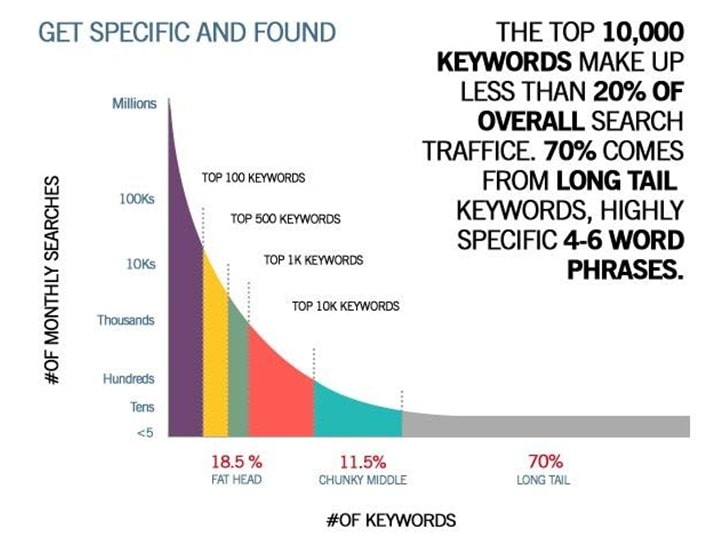
How Long-Tail Keyword Impact SERP Rankings
Long-tail keywords that are four to six words long are recommended by SEO specialists because they are more precise and are usually what people type into search engines. For instance, if your business is food delivery, the generic keyword would be “food delivery.” A better key phrase would be more specific, like “24/7 food delivery in (specific locality you serve).”
It bodes well for you because people would usually search for products and services near them. Instead of a hit-and-miss situation with a generic keyword, you can focus your keywords strategies on users within your preferred demographic, thus landing more chances of making a sale or conversion.
It is how you can outrank competitors serving your area. You can even create niche long-tail keywords like “24/7 food delivery in (location) for big events” or “24/7 Vegan food delivery in (location).”
Through Latent Semantic Indexing, search engines consider the context of keywords, not just the words you use. It’s not just about stuffing keywords but also about matching the quality of those keywords to your audience’s search intent.
Google’s Penguin and Panda removes all sites with weak or dying results out of its SERP results. You do not want to be part of SERP casualty with weak, expensive, and generic keywords. Long-tail and more specific keywords are also a priority for Google’s Hummingbird, with an updated algorithm to identify more valuable, ranking, and specific keywords.
While it is true that long-tail keywords get less search traffic, the competition is lessened to a degree where even new websites can rank on SERP in no time. When you use long-tail keywords, you get a more reliable traffic flow with a higher conversion capacity.
Using long-tail keywords helps your generic or short-tail keywords as well. They boost ranking for short-tail keywords, primarily if you use internal linking within your content containing your long-tail keywords.
For instance, if you search for a head-to-head comparison of Windows OS and MacOS, you will probably click results with a detailed comparison or content that comes with an infographic. Within that article, you can link your short-tail keywords, like “Windows OS,” to boost your short-tail or generic keyword.
Another example of putting long-tail keywords to good use is creating content about a product review or comparison. Instead of simply using the generic keywords “TurboCad,” you can create content such as “TurboCad vs Solidworks – Which is the Better 3D Program.” Specific content such as this gains more engagement from their readers, and with the infographic, gets more social shares.
Tools You Can Use to Identify Long-Tail Keywords
● Google Keyword Planner (Free)
To increase traffic to your website, Google has given you a free tool in Google Keyword Planner. This SEO tool is a great help in providing SEO insights, one of which is what keyword to use.
With each keyword search, you can enter multiple seed words, phrases, or even a URL. Search terms can generate hundreds or even thousands of ideas in response.
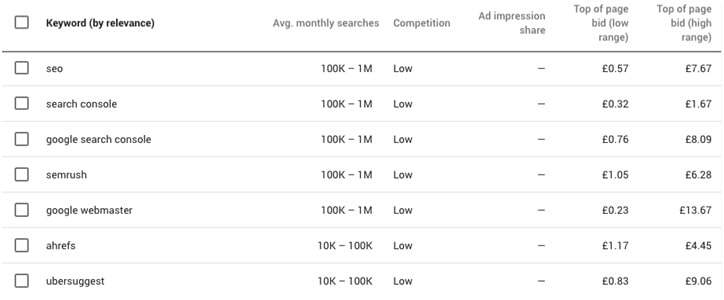

You will see metrics such as how many clicks and impressions you might expect to get from keywords and estimated costs to view. Most SEO strategists use the free version of Google Keyword Planner to deliver winning long-tail keywords.

● LSI Graph (Free)
LSI Graph is available for free and has user-friendly features with high-quality options. If you just use it to find keywords, the free version is more than enough. You can go straight to Keyword Research is right on its landing page.
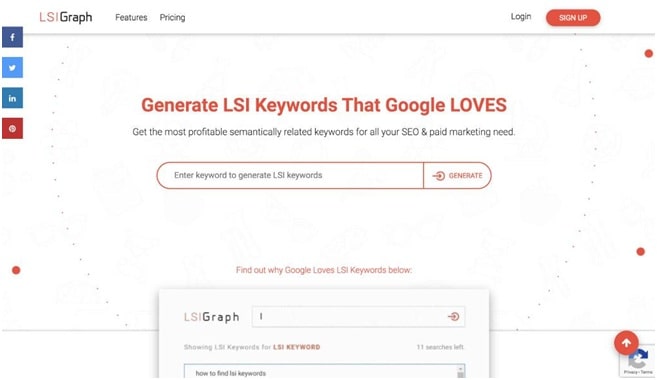
For instance, you run a general search query such as “website” and see results like this:
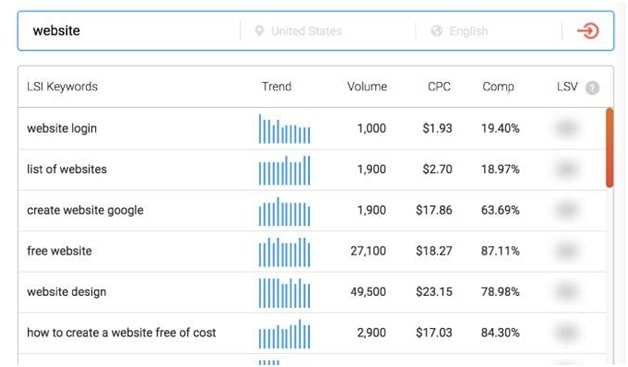
As you scan through the list of keywords, you’ll see those long-tail terms further down the list:
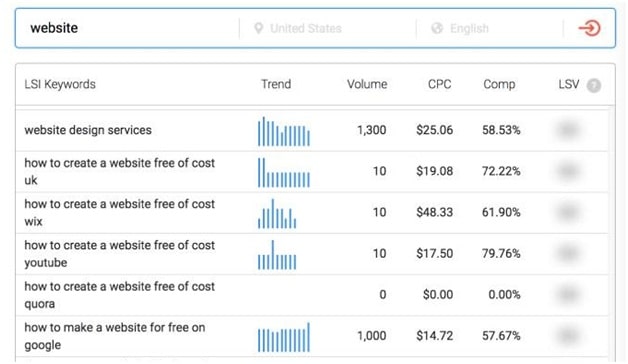
The free keyword tool provides you with a lot of data, but not all of the long-tail keywords. You can also see search volume, competition (Comp percent), and Cost per Click (CPC).
When you hover right of a keyword, a red box appears and clicking it displays more long-tail keyword options.
This process can be repeated until you find what you’re looking for, making it a very efficient free tool.
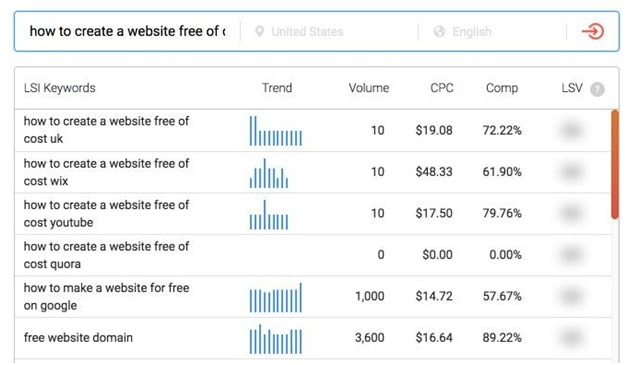
● SEMrush (Paid)
This tool will improve your SEO. It isn’t cheap but is worth the price. Its keywords search tools and content template are a fan favorite, giving you keyword focus choices and paste content for analysis in terms of SEO, readability, tone, and originality.
● Ahrefs (Paid)
Ahref’s blog posts are lengthy and highly detailed, and their SEO keyword tool is particularly beneficial. It comes with a free 7-day trial, no questions asked. It offers a diverse array of tools like the site, keywords, and content explorer to help you look for the best possible keywords and key phrases to incorporate in your content.
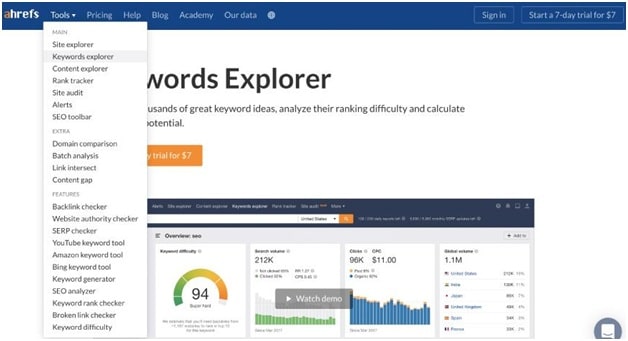
Where to Use Long-Tail Keywords
1. Headlines
The key is to use keywords organically and seamlessly, so continue working on your keywords until it sounds natural. You may need to revise your keywords in the future to remain relevant with trending search queries, as Google and other search engines prioritize relevance and readability. People should be able to understand the basic concepts of your content without having to dig through the body of the article.
2. Introduction
Integrate your new long keywords into the first 100 words of your article. Avoid keyword stuffing because your content will be flagged as spam. Again, keywords should appear and feel natural, so write them in a normal, conversational manner. These key phrases make your text more relatable and entice your readers to continue reading.
3. Sub-Points
If possible, include long-tail keywords in some of your sub-points. You should add a second or third keyword to include at least two or three versions of your keywords in your article.
4. Conclusion
Content should land impeccably through its conclusion to give your content finality and more authority. Use appropriate writing techniques like providing a summary of the article or stressing a final point towards a conversion.
Those who merely skim through articles must grasp the gist of the content, just as the introduction should as well. Reemphasize points you made in your introduction, including any premise you introduced, and provide your final concurrence on the topic.
It is also good to end with a solid and compelling CTA (Call-to-Action) to encourage more conversions from your readers, even those who just skimmed through your content.
Conclusion: Consistently Use Long-Tail Keywords
Keep a sharp focus on longer keyword phrases when formulating your content strategy, and practice it consistently.
Outranking your competitor will become intuitive and easy for you and your team as you become consistent with this writing style. So, if you are not doing it already, start using long-tail keywords on your SEO strategies now.
